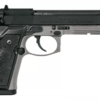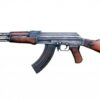AKM
$1,599.90
AKM — Modernized Kalashnikov Rifle (7.62×39)
Focus keyphrase: AKM rifle
The AKM (Автома́т Кала́шникова модернизи́рованный — Avtomát Kalášnikova modernizírovannyj) is the modernized, mass‑production evolution of the original AK‑47 designed by Mikhail Kalashnikov. Chambered in 7.62×39mm, the AKM introduced manufacturing improvements and weight reductions that made the Kalashnikov family easier and cheaper to produce while retaining legendary reliability. First produced in 1959, the AKM remains in service worldwide.
Key Specifications
-
Cartridge: 7.62×39mm M43
-
Muzzle velocity: ~715 m/s (2,346 ft/s) (varies with load and barrel length)
-
Designed by: Mikhail Kalashnikov
-
Produced: 1959–1977 (Soviet Union initial production; continued under license worldwide)
-
Service: 1959–present (used by military, paramilitary and non‑state actors globally)
-
Action: Gas‑operated, rotating bolt
-
Typical features: stamped receiver (lighter than original milled AK‑47), slotted muzzle brake, simplified sights, improved safety/selector, updated manufacturing processes for mass production
History & Design Improvements
The AKM was introduced to modernize and simplify manufacture of the AK‑47. Major changes from the original included a stamped sheet‑steel receiver (reducing weight and cost), a redesigned stock and handguard, a lighter profile, and improved production techniques. These changes preserved the AK’s characteristic robustness while enabling economical large‑scale production across the Soviet bloc and allied nations.
Performance & Use
The AKM is valued for:
-
Reliability: Functions under sand, mud, and extreme conditions.
-
Simplicity: Easy to maintain and operate with minimal training.
-
Durability: Proven service life in combat zones worldwide.
-
Ballistics: The 7.62×39 round delivers effective intermediate‑range terminal performance; muzzle velocity is typically around 715 m/s depending on ammunition and barrel.
Common roles include standard infantry service rifle, vehicle armament, and use by irregular forces. Many licensed and unlicensed variants and modernizations exist, including improved accuracy and ergonomic upgrades.
Variants & Global Production
Following Soviet adoption, the AKM was produced under license and copied widely. Notable variants and local productions include rifles and carbine formats from Eastern Europe, Asia, and elsewhere. Derivative platforms chambered in other calibers (5.45×39, .223/5.56) and modernized builds with rails, optics, and accessory options are also common.
Safety & Legal Reminder
Firearm ownership, transfer, and use are governed by federal, state, and local laws that vary by jurisdiction. Always follow applicable laws and safe handling practices. Purchases from online sellers must ship to a licensed FFL for transfer where required.
FAQ — AKM Rifle
Q: What caliber is the AKM?
A: The AKM is chambered in 7.62×39mm (M43).
Q: How fast is an AKM round?
A: Typical muzzle velocity for standard 7.62×39 loads is around 715 m/s (2,346 ft/s), but this varies by projectile weight and barrel length.
Q: When was the AKM produced and introduced?
A: The AKM entered production in 1959; initial Soviet production ran through the 1960s–1970s and continued worldwide under license thereafter.
Q: How does the AKM differ from the AK‑47?
A: The AKM introduced a stamped receiver (lighter and cheaper than the AK‑47’s milled receiver), manufacturing simplifications, and minor ergonomic and functional refinements while preserving the AK operating system.
Q: Is the AKM still used today?
A: Yes — the AKM and its variants remain in service globally with many armed forces, militias, and civilian shooters.
Related products
Rimfires
Rifles
Rifles
Rifles
Handguns
Rimfires














